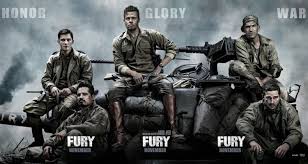Movie Watch: Fury
They call him “Wardaddy.” But Sgt. Don Collier doesn’t take it as a comment on his age. Or as an insult. It’s just his nickname, a label that each member of a tank crew earns.
Oct 30, 2014

They call him “Wardaddy.” But Sgt. Don Collier doesn’t take it as a comment on his age. Or as an insult. It’s just his nickname, a label that each member of a tank crew earns.
Collier’s comes from the fact that he’s commanded this motley assortment of soldiers for a long time. They were killing Germans in North Africa way back when. They fought through Italy and Normandy. And years later, they’re still all fighting together, making their way across Germany in the waning days of World War II.
It’s the spring of 1945, and you can feel that this nasty war is in its endgame. But there’s still a lot of fighting to be done. And it’s more dangerous now than ever. The enemy is desperate, in retreat and setting up for a suicidal last stand. And even though Hitler may have had to start forcing children into the battle to bolster his troops, the German army still has plenty of tanks, brutal beasts of war more heavily armoured and powerful than anything the Americans can field.
That, however, won’t stop Collier’s crew. With a new private manning the bow gun, they’ll be giving more than they get. Sure, that Norman kid is green — afraid of dying and even more afraid to pull a trigger—but they’ll knock him into shape. Once he gets an eyeball of what war can do, when he sees what horrors one man can do to another man, he won't be dragging his feet on killing any more. After all, they scrawled “Fury” on the barrel of their M-4 Sherman’s big gun for a reason: Collier and Co. plan on delivering the fury of the American fighting machine ‘til every last dirty German is dead and gone!
Positive Elements
World War II has often been idealized in film. Not so here.
“As black and white as the conflict was—this struggle of good versus evil—liberating Europe from slavery, no less, people assume the fighting was also black and white. It wasn’t. It was just as morally hazardous and spiritually toxic as anything that happened in Vietnam,” director David Ayers said in a chron.com article. To that end, Pvt. Norman Ellison is our everyman on-screen representative who, early on, balks at and struggles against the cruelty and borderline criminal actions of his battlefield compatriots. He even offers to die himself rather than murder an unarmed prisoner.
Even though Norman’s attitudes shift by movie’s end, he, Sgt. Collier and the rest of his crew stick by each other’s sides and heroically defend an important military objective. Elsewhere, a German officer inexplicably lets a captured American soldier go rather than killing him.
Spiritual Content
When Norman first shows up, he’s grilled by another tank crewman about his salvation. We find out that this guy, nicknamed “Bible,” is a “fundamentalist Christian.” We see him praying over a wounded soldier and quoting Scripture several times before battle. That said, his faith doesn’t keep Bible from being every bit as foul mouthed, boozy and death-dealing as the rest of his crew. In fact, he rationalizes that relishing the slaughter of the enemy is a positive thing since it’s “God’s work.” “I am the instrument, not the hand,” he intones.
Norman, we find out, is a Presbyterian. His faith informs his initial hesitation with regard to following in his crewmates’ crude and deadly directions. But he tosses those convictions aside fairly quickly in the bloody heat of battle.
For his part, Sgt. Collier generally scoffs at the idea of God’s hand being involved in their lives, even though he later demonstrates some knowledge of the Bible by quoting from the Book of Isaiah.
Sexual Content
While travelling a muddy roadway in their tank, Norman sees a pretty young woman on the side of the road. One of his fellow crewmembers points out that she would likely have sex with him for a candy bar. That statement is borne out later when women readily accept small payments and accompany soldiers for offscreen sexual trysts. While helping a woman up on his tank in another scene, a soldier hikes up her skirt.
In a captured German town, Sgt. Collier takes Norman up to the apartment of two women. He pays food and cigarettes for Norman to share the youngest woman’s bed behind closed doors. (It should be noted, however, that this is not played as a rape or coerced sex, but as an absurdly scripted romantic moment for both Norman and the German girl.)
Soldiers joke about “whores” and performing sexual acts with Hitler.
Violent Content
“I didn’t want a typical narrative,” director Ayers said. “If you look at film, it’s like it goes from Pearl Harbour to Saving Private Ryan and then the victory parade. But the Germans held on until the bitter end. Four weeks from the end of the war, there were some horrific things going on.”
Fury takes every chance it can to show those horrific things in red-slimed detail. Scores and scores of men, women and children are battered and butchered for the camera’s eye—and ours—to see.
For example, in the film’s opening scene, Sgt. Collier surprises a German officer, knocks the man off his horse and repeatedly stabs him in the face, gouging out an eye. In another scene, a tank gets hit with an incendiary device that sets it, and its passengers, ablaze. One man tumbles out, covered in flames and gorily shoots himself in the head to stop the agony. When Norman first arrives, he’s ordered to clean out the seat of his recently killed predecessor. While mopping out the blood, he also finds graphic, sizeable remains of the man’s blown-off face.
Among the film’s many other grisly images, we see: heads blown apart by machine guns and tank shells, corpses crushed under tank treads, German children hung for refusing to fight, prisoners shot while surrendering, a soldier’s skull crushed by an attacker’s boot, child soldiers mowed down by gunfire, men blown into chunks by grenades, a woman butchering a dead horse for meat, military vehicles erupting in explosions, buildings and their occupants demolished by artillery fire, the corpses of a group of German officers and women who apparently committed suicide together and bulldozers pushing piles of bloodied corpses.
While brutally ripping their way through an overwhelming SS battalion—and waiting for their own deaths to inevitably occur—Sgt. Collier and his crew all profess that killing Germans is, “The best job I ever had.”
Other Negative Elements
Sgt Collier’s crew is a loyal group, but they routinely batter each other with insults and racial slurs. Norman vomits after making a bloody discovery. Conclusion “Ideals are peaceful, history is violent,” Sgt. Collier tells a horrified and recoiling Norman Ellison. This movie wants to make sure we know that, smell that and chew on that violent truth. In fact, Fury rubs our cinematic faces in two hours of grimy, dirty, intensely ferocious, charred-flesh misery to make sure the point is crystal clear.
Some will see that unflinching glimpse of perpetual bloodshed and grey-smoking destruction as something of an anti-war declaration. They’ll see a cautionary tale of men hollowed-out and broken by the unspeakable horrors they’ve witnessed.
Others, however, will see this pic as a one-dimensional splatter-fest dressed up in khaki army fatigues, with limbs innumerable being severed by high-caliber machine gun fire and mortar rounds in a story of brutal, hard-fisted soldiers battling a Nazi evil even more wicked than themselves.
Both groups will be right. The film’s creators crafted it that way on purpose. But no matter which interpretive path you take, what seems inarguable is how profanely foul, excruciatingly graphic, unwaveringly nihilistic and downright ugly, both of those paths nevertheless remain.







Total Comments:0